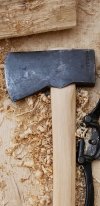I can't think through what format we can communicate in,so this is to collect and roughly collate some general information,and exchange some loose thoughts and ideas.
Maybe at some point we can streamline this format/process,i only wanted to ask a few questions,and share some preliminary actions on this end.
So,at this point,to the best of my knowledge we're looking at 3 originals.They're Old Axeman's axes #1 and #2,and the "1905"-marked one posted by user Imalterna.
(it'd be stating the obvious to say "the more-the merrier" ).
).
We don't have any measurements of any of the above barring their Weight.Not a biggie,as between the weight and general proportions all the info is there;but,if anyone can throw a caliper around about any of the originals it won't hurt either.
That eye-shape is curious,definitely a distinguishing feature of these(seems to me,please feel free to express your own take on any and ALL being said here).
Presuming the above i went ahead and forged a preliminary drift.
Stock was a hex 1 1/8" across the flats(pavement breaker point),and what i got out of it was 2" wide by a fat 1/2",convex shape.
This is what it looked like forged,(the sledge next to it is 3 lbs;just as a thought,2+lb axe can kinda be imagined).
https://imgur.com/a/sOIeSWb
And here it is slightly cleaned up,anhd Above the drift that was used on that first trial;that drift is sized for a commercially available handles sold for lathing,half-hatchets,et c.
It is of course tear-drop shaped,just a touch Thicker at it's thickest,and just under in Width than the new one.
https://imgur.com/oKrhWmI
All in all,it should produce an eye somewhat flatter in profile than a cruiser or DB,2" long.(Thickness may vary,it can be adjusted artificially,by spreading the eye a touch by hand).
I also had a chance to process some stock,both 1/2" for folding,and 3/4" for slitting potential.
https://imgur.com/a/DsKBfkS
Everything,for starters,is in 2" widths.
Maybe at some point we can streamline this format/process,i only wanted to ask a few questions,and share some preliminary actions on this end.
So,at this point,to the best of my knowledge we're looking at 3 originals.They're Old Axeman's axes #1 and #2,and the "1905"-marked one posted by user Imalterna.
(it'd be stating the obvious to say "the more-the merrier"
We don't have any measurements of any of the above barring their Weight.Not a biggie,as between the weight and general proportions all the info is there;but,if anyone can throw a caliper around about any of the originals it won't hurt either.
That eye-shape is curious,definitely a distinguishing feature of these(seems to me,please feel free to express your own take on any and ALL being said here).
Presuming the above i went ahead and forged a preliminary drift.
Stock was a hex 1 1/8" across the flats(pavement breaker point),and what i got out of it was 2" wide by a fat 1/2",convex shape.
This is what it looked like forged,(the sledge next to it is 3 lbs;just as a thought,2+lb axe can kinda be imagined).
https://imgur.com/a/sOIeSWb
And here it is slightly cleaned up,anhd Above the drift that was used on that first trial;that drift is sized for a commercially available handles sold for lathing,half-hatchets,et c.
It is of course tear-drop shaped,just a touch Thicker at it's thickest,and just under in Width than the new one.
https://imgur.com/oKrhWmI
All in all,it should produce an eye somewhat flatter in profile than a cruiser or DB,2" long.(Thickness may vary,it can be adjusted artificially,by spreading the eye a touch by hand).
I also had a chance to process some stock,both 1/2" for folding,and 3/4" for slitting potential.
https://imgur.com/a/DsKBfkS
Everything,for starters,is in 2" widths.












